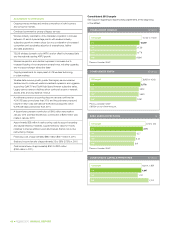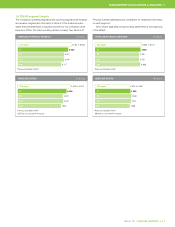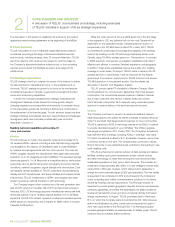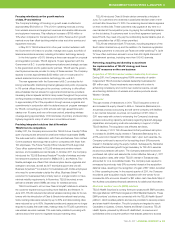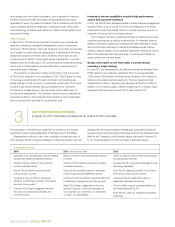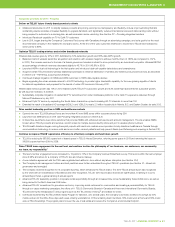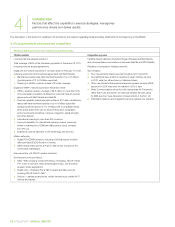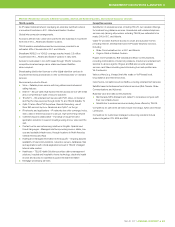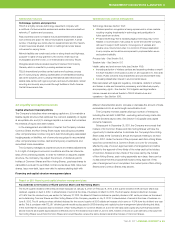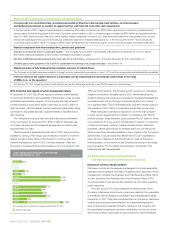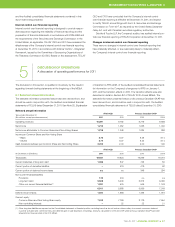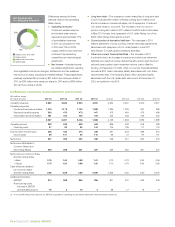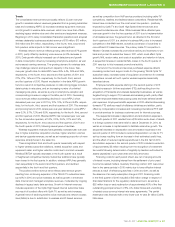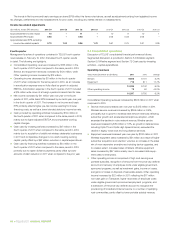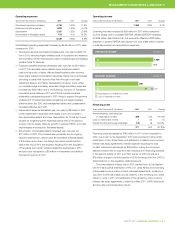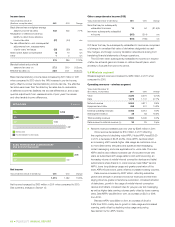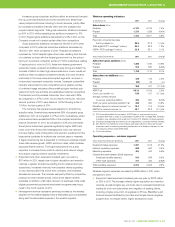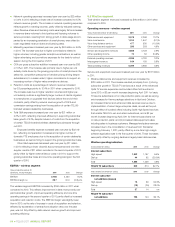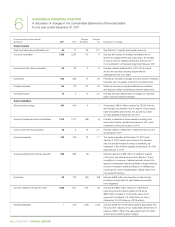Telus 2011 Annual Report Download - page 60
Download and view the complete annual report
Please find page 60 of the 2011 Telus annual report below. You can navigate through the pages in the report by either clicking on the pages listed below, or by using the keyword search tool below to find specific information within the annual report.
56 . TELUS 2011 ANNUAL REPORT
Report on 2011 financing and capital structure management plans
Use proceeds from securitized trade receivables (presented as Short-term borrowings), bank facilities, commercial paper
and dividend reinvestment, as needed, to supplement free cash flow and meet other cash requirements
In the first quarter of 2011, issued commercial paper increased by $150 million to help fund the $200 million discretionary contribution to defined benefit
pension plans, as well as acquisitions in the period. During the second quarter of 2011, commercial paper increased by $728 million and supplemented the
May 2011, $600 million five-year Note issue, which together enabled repayment of matured U.S. dollar Notes and settlement of associated cross currency
interest rate swap agreements, as well as funding an additional investment in Transactel (Barbados) Inc. In the third quarter of 2011, TELUS reduced its
commercial paper by $221 million to a balance of $761 million at September 30. In the fourth quarter of 2011, commercial paper increased by $5 million.
Maintain compliance with financial objectives, policies and guidelines
Maintain a minimum $1 billion in unutilized liquidity – The Company had unutilized credit facilities of $1.28 billion at December 31, 2011, as well as
$100 million additional availability under the trade receivables securitization program.
Net debt to EBITDA excluding restructuring costs ratio of 1.5 to 2.0 times – Actual result of 1.8 times at December 31, 2011. See Section 7.4.
Dividend payout ratio guideline of 55 to 65% of sustainable net earnings on a prospective basis – See Section 7.4.
Maintain position of fully hedging foreign exchange exposure for indebtedness
The Company’s only debt issue denominated in a foreign currency matured and was repaid on June 1, 2011, and the corresponding derivative liability was settled.
Preserve access to the capital markets at a reasonable cost by maintaining investment grade credit ratings in the range
of BBB+ to A–, or the equivalent
At February 23, 2012, investment grade credit ratings from the four rating agencies that cover TELUS were in the desired range.
2012 financing and capital structure management plans
At December 31, 2011, TELUS had access to undrawn credit facilities
of more than $1.28 billion and availability of $100 million under its trade
receivables securitization program. The Company also had access to
a shelf prospectus pursuant to which it can issue up to $2.5 billion of
debt and equity. TELUS believes that its investment grade credit ratings
contribute to reasonable access to capital markets to facilitate future
debt issuance.
The Company’s long-term debt principal maturities are illustrated
in the chart below. At the end of 2011, 83% of TELUS’ total debt was
on a fixed-rate basis and the weighted average term to maturity was
approximately 5.6 years.
TELUS expects to generate free cash flow in 2012, which would be
available to, among other things, pay dividends to holders of Common
Shares and Non-Voting Shares. TELUS plans to continue with two
dividend increases per year to 2013, normally declared in May and
November, and expects the annual increase to be in the range of circa
10% over this timeframe. The dividend growth model is not necessarily
indicative of dividend increases beyond 2013. Notwithstanding this,
dividend decisions will continue to be subject to the Board’s assessment
and determination of the Company’s financial situation and outlook
on a quarterly basis. TELUS is maintaining its long-term dividend payout
ratio guideline of 55 to 65% of prospective sustainable net earnings.
While anticipated cash flow is expected to be more than sufficient
to meet current requirements and remain in compliance with TELUS’
financial policies, these intentions could constrain TELUS’ ability to invest
in its operations for future growth. As described in Section 1.5, payment
of cash income taxes, funding of defined benefit pension plans and,
potentially, capital expenditures for wireless spectrum, will reduce the
after-tax cash flow otherwise available to return capital to the Company’s
shareholders. If actual results are different from TELUS’ expectations,
there can be no assurance that TELUS will not need to change its
financing plans, or its intention to pay dividends according to the target
payout guideline. For the related risk discussion, see Section 10.6
Financing and debt requirements.
4.4 Disclosure controls and procedures
and internal control over financial reporting
Disclosure controls and procedures
Disclosure controls and procedures are designed to provide reasonable
assurance that all relevant information is gathered and reported to senior
management, including the President and Chief Executive Officer (CEO)
and the Executive Vice-President and Chief Financial Officer (CFO),
on a timely basis so that appropriate decisions can be made regarding
public disclosure.
The CEO and the CFO have evaluated the effectiveness of the
Company’s disclosure controls and procedures related to the preparation
of the MD&A and the Audited consolidated financial statements dated
December 31, 2011. They have concluded that the Company’s disclosure
controls and procedures were effective, at a reasonable assurance
level, to ensure that material information relating to the Company and
its consolidated subsidiaries would be made known to them by others
within those entities, particularly during the period in which the MD&A
LONG-TERM DEBT PRINCIPAL MATURITIES
AS AT DECEMBER 31, 2011 ($ millions)
The average term to maturity is 5.6 years at December 31, 2011.
700
625
1,066
300
300 766
2025
2024
2023
2022
2021
2020
2019
2018
2017
2016 600
2015
2013
2014
2012
700
1,000
1,000
175
249
200
Commercial paper


